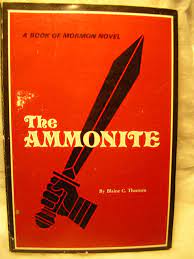Articles/Essays – Volume 13, No. 2
The Book of Mormon as Faction | Blaine C. Thomsen, The Ammonite
Following the phenomenal success of his book-turned-TV mini-series, Alex Haley described his work Roots as “faction,” a careful combination of history and fiction. Using what names, dates and places he could find in the records as a skeleton, he proceeded to flesh out the story with what could have happened. The Book of Mormon seems ripe for this same treatment, as has the Bible with its countless epics only sketchily covered in the record itself. (We have suffered through enough biblical novels and DeMille-type films to fill a good-sized urban dump.) While The Ammonite, a new Book of Mormon novel by a former LDS missionary turned RLDS, is not the first (nor will it be the last) attempt to make a “historical novel” out of the Mormon canon, it deserves attention because of its glaring problems and deficiencies if for nothing else.
As I was reading through the book the first time, I encountered one of the most serious problems with “factionized” scripture. My thoughts continually wandered from the story as I tried to recall Book of Mormon characters, events and places from my memories of the actual scripture. As the story became more complex and as I worked to remember from page to page, the ever-presence of the Book of Mormon and the additions to it the novelist felt impelled to make caused me more displeasure than the experience was .worth. To follow the basic character Jarom was not difficult, but deciphering the rest and keeping them where they belong was absolutely tedious.
The cover blurb on The Ammonite tells of the research Thomsen did before beginning to write. In the preface, Thomsen tries to give his book an archeological flavor by having an Indian encounter a scholar and recite to him the legend that is supposedly the basis of the story. In keeping with this pseudo-scientific flavoring, Thomsen calls his peoples Highlanders and Lowlanders instead of the more-familiar Lamanite/Nephites. The result is more confusion as the reader familiar with the Book of Mormon tries to keep separate or together (never knowing which Thomsen wanted) the novel and the Book of Mormon itself.
Even after a second reading of the Book of Mormon story, I found myself confused over many of Thomsen’s impressions. For example, I find it hard to believe that Samuel the Lamanite, who turns up in the end of the book, had blond hair and blue eyes. Whether Thomsen felt that changing Samuel into a Nordic made him more heroic and therefore within his literary license seems beyond the point, although Thomsen does make Samuel only half Lamanite. There are numerous other aspects of the novel that make little sense in light of the Book of Mormon story itself. Indeed, it reminds me of Harry Anderson’s paintings in which all of the characters from the New Testament appear as non-Semitic as an average Norwegian. Thomsen seems to think the Book of Mormon would be much better if rewritten in the same ethnocentric way.
While few novels based upon scripture hit the mark as first-class literature, it is unfortunate that the Book of Mormon, with all of its drama and pageantry, has not yet inspired good fiction. (This one might be interesting to someone with no Book of Mormon knowledge, but then the whole point of it is gone.) Haley’s Roots might have been interesting without its genealogical implications, but it became an astounding success as literature because of them. The Ammonite is neither good fiction nor good faction. Either Thomsen should have written a novel faithful to what he could discern from the record, or he should have forgotten the pretense completely.
The Ammonite. By Blaine C. Thomsen. Independence, Mo.: Herald Publishing House, 1979, 292 pp., $6.95.


 Back to full Issue
Back to full Issue

